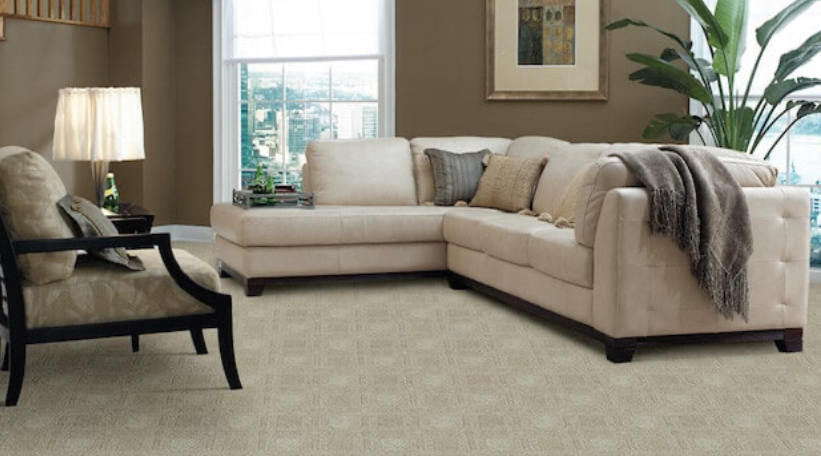Consider these principles when selecting a carpet for your home.
By Tammy Adamson-McMullen
Carpet is one of the most beautiful investments you can make for your home, but choosing the right one can be challenging. It’s not always easy to choose the right carpet for a specific space, with so many piles and materials to choose from, or to visualize how a specific color will look in your home. Below are some basic principles to help (which apply to area rugs as well).
Right Color
When shopping for carpet, many homeowners solve the challenge of color selection with a neutral shade. This can be a good solution, provided that the neutral coordinates with other colors in the space. For example, a warm-toned carpet wouldn’t work in a room with a cool color scheme, and vice versa. Still, neutral carpets have advantages.
- Neutrals have staying power because they coordinate with just about anything. Even if you decide to change a room’s color scheme down the road, there’s a good chance your neutral carpet will harmonize with it.
- Neutrals are soothing, making them ideal in places where you want peace and relaxation, such as bedrooms and sitting areas.
- They also make a home easier to sell by allowing potential buyers to visualize their own furnishings in the space.
If you’re leaning toward a neutral carpet, what color should you choose? If your furnishings are dark, brightly colored or patterned, opt for a carpet in a light neutral—such as cream or beige—that will showcase them. If your furnishings are plain and light in color, ground them with a darker carpet, like charcoal or a deep taupe.
That being said, if you have plainer furnishings, you can get a little more adventurous in your carpet selection. You might try a multi-colored carpet with flecks of neutrals or more colorful hues; a two-toned carpet that matches the walls or another design element in the room; or even a patterned carpet, like a floral, geometric, abstract or animal print (which is trending).
If you prefer stronger colors underfoot, then by all means, go for it! Just be sure to choose a carpet color that complements other colors in the space and flows with your general color scheme.
Right Shade for a Small Space
Furnishings aside, many homeowners stress about whether they should choose a light or dark carpet, especially for a small space. In general, lighter colors reflect light and therefore create an illusion of more space, while darker colors absorb light and make a space feel smaller. With this principle in mind, most color experts will tell you to choose a lighter-colored carpet to “expand” a small space. Off-white, cream, light taupe and soft pastels are good examples.
However, this rule isn’t without exceptions. A darker carpet can make a space look larger, too, provided that there is ample natural light in the space, the carpet isn’t too busy in pattern, and it’s allowed to flow beyond the space. Additionally, darker carpets can make a room appear taller when the wall color is lighter and the ceiling color is lighter yet. The lighter colors draw the upward.
Another trick in making a room appear larger is to match the walls to the carpet. However, this rule works better when all of the colors are lighter in hue—again, because of light absorption.
Right Pile
Carpets are made of fiber yarns which create different piles according to the way they’re treated. To select the right pile for a given space, you need to understand their benefits and disadvantages.
Cut Pile or Plush—Soft to the touch, the exposed yarns in these carpets are twisted and sheared to an even pile height, creating a fuzzy top. Cut piles include:
- Shag—Extra-long yarns create a soft carpet; nice for bedrooms but tends to trap dirt.
- Velvet or Saxony—Plush, dense yarns are lush and sumptuous; ideal for a master bedroom, dining room or living but is susceptible to footprint/vacuum marks.
- Frieze—Tightly twisted and kinked yarns create a durable, usually multi-colored carpet that hides dirt; a good solution for high-traffic areas.
- Texturized—Alternating twists of yarns are sheared to different heights and then kinked, creating a durable carpet that holds up to busy families.
- Cable—Long, thick fibers are comfy underfoot but can become matted, making them unsuitable for high-traffic areas.
Loop—Great for high-traffic areas, these carpets have uncut yarns that are durable, easy to clean and “trackless” but are less soft than cut-pile carpets. Because of their loops, they also tend to snag.
Cut-and-Loop or Sculpted—Low in profile, these carpets—also known as “patterned”—have both cut and looped yarns. They’re well-suited for high-traffic areas, but seams can be difficult to hide.
Right Material
Now, which material of carpet should you choose? A list of major categories is below, but be aware that there are blends available, too.
Nylon—Extremely durable, this is the top-selling carpet. Nylon carpets are stain- and soil-resistant, come in beautiful colors and are easy to maintain.
Polyester—Valued for its ability to retain color, this luxurious carpet is stain- and moisture-resistant, but it doesn’t hold up to weight or heavy foot traffic.
Olefin—Often used in loop constructions, this polypropylene compound looks like wool without the high price. However, carpets in higher piles are easily crushed and unsuitable for high-traffic areas.
Acrylic—This budget-friendly synthetic, often called “synthetic wool,” is stain- and fade-resistant but not as durable as other materials. It’s sometimes blended with wool.
Wool—Luxurious and soft, the real thing resists dirt and stains but is a more expensive choice.
These principles should help guide your selection. But be sure to ask your local paint and decorating retailer about the latest carpet offerings on the market.

 Interior Paints
Interior Paints Exterior Paints
Exterior Paints Primers
Primers Stains & Clears
Stains & Clears
 Paint Brushes
Paint Brushes Paint Roller
Paint Roller Paint Trays & Liners
Paint Trays & Liners
